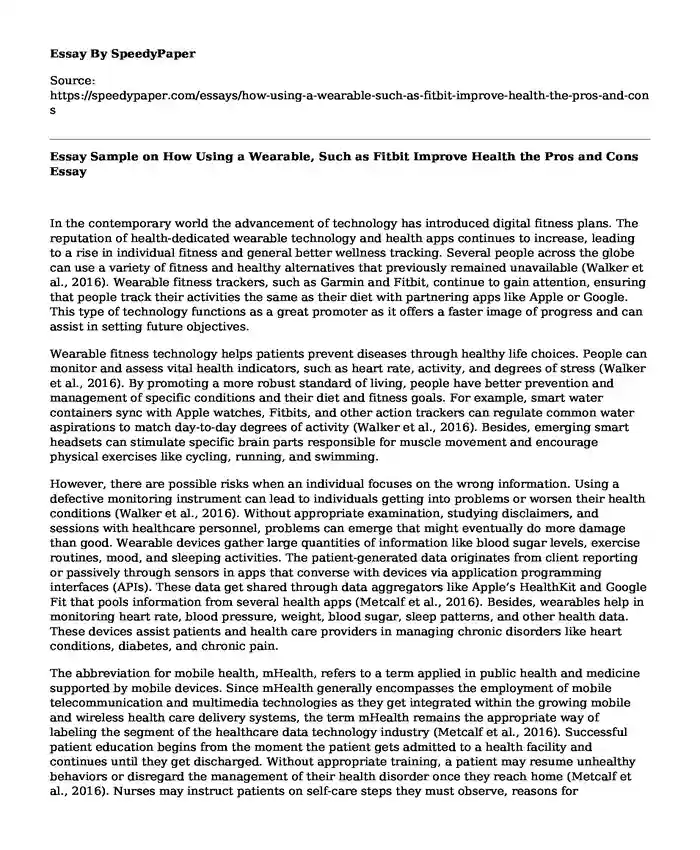
| Type of paper: | Essay |
| Categories: | Software Electronics Community health |
| Pages: | 3 |
| Wordcount: | 609 words |
In the contemporary world the advancement of technology has introduced digital fitness plans. The reputation of health-dedicated wearable technology and health apps continues to increase, leading to a rise in individual fitness and general better wellness tracking. Several people across the globe can use a variety of fitness and healthy alternatives that previously remained unavailable (Walker et al., 2016). Wearable fitness trackers, such as Garmin and Fitbit, continue to gain attention, ensuring that people track their activities the same as their diet with partnering apps like Apple or Google. This type of technology functions as a great promoter as it offers a faster image of progress and can assist in setting future objectives.
Wearable fitness technology helps patients prevent diseases through healthy life choices. People can monitor and assess vital health indicators, such as heart rate, activity, and degrees of stress (Walker et al., 2016). By promoting a more robust standard of living, people have better prevention and management of specific conditions and their diet and fitness goals. For example, smart water containers sync with Apple watches, Fitbits, and other action trackers can regulate common water aspirations to match day-to-day degrees of activity (Walker et al., 2016). Besides, emerging smart headsets can stimulate specific brain parts responsible for muscle movement and encourage physical exercises like cycling, running, and swimming.
However, there are possible risks when an individual focuses on the wrong information. Using a defective monitoring instrument can lead to individuals getting into problems or worsen their health conditions (Walker et al., 2016). Without appropriate examination, studying disclaimers, and sessions with healthcare personnel, problems can emerge that might eventually do more damage than good. Wearable devices gather large quantities of information like blood sugar levels, exercise routines, mood, and sleeping activities. The patient-generated data originates from client reporting or passively through sensors in apps that converse with devices via application programming interfaces (APIs). These data get shared through data aggregators like Apple’s HealthKit and Google Fit that pools information from several health apps (Metcalf et al., 2016). Besides, wearables help in monitoring heart rate, blood pressure, weight, blood sugar, sleep patterns, and other health data. These devices assist patients and health care providers in managing chronic disorders like heart conditions, diabetes, and chronic pain.
The abbreviation for mobile health, mHealth, refers to a term applied in public health and medicine supported by mobile devices. Since mHealth generally encompasses the employment of mobile telecommunication and multimedia technologies as they get integrated within the growing mobile and wireless health care delivery systems, the term mHealth remains the appropriate way of labeling the segment of the healthcare data technology industry (Metcalf et al., 2016). Successful patient education begins from the moment the patient gets admitted to a health facility and continues until they get discharged. Without appropriate training, a patient may resume unhealthy behaviors or disregard the management of their health disorder once they reach home (Metcalf et al., 2016). Nurses may instruct patients on self-care steps they must observe, reasons for maintaining self-care, and how to identify warning signals. Furthermore, nurses can advise patients on actions they can take if a problem happens and who to contact if they have queries.
References
Metcalf, D., Milliard, S. T., Gomez, M., & Schwartz, M. (2016). Wearables and the internet of things for health: Wearable, interconnected devices promise more efficient and comprehensive health care. IEEE pulse, 7(5), 35-39. www.ieeexplore.ieee.org/abstract/document/7579253/
Walker, R. K., Hickey, A. M., & Freedson, P. S. (2016). Advantages and limitations of wearable activity trackers: Considerations for patients and clinicians. Clin J Oncol Nurs, 20(6), 606-10. www.pdfs.semanticscholar.org/1700/daf7d2b42ad2689f3284d95e6779d6b7c0ce.pdf
Cite this page
Essay Sample on How Using a Wearable, Such as Fitbit Improve Health the Pros and Cons. (2023, Sep 18). Retrieved from https://speedypaper.com/essays/how-using-a-wearable-such-as-fitbit-improve-health-the-pros-and-cons
Request Removal
If you are the original author of this essay and no longer wish to have it published on the SpeedyPaper website, please click below to request its removal:
- Apply Digital Solutions to Work - Essay Sample for Everyone
- Law Essay Example: Terry Schiavo's Case Controversy
- Essay Example: Children's Skin Disorders
- Essay Sample on Technology Effect on Healthcare
- Free Essay Example: Concepts of Aging
- Drug Addiction - Essay Example
- Essay Sample on Coronavirus Cases
Popular categories




